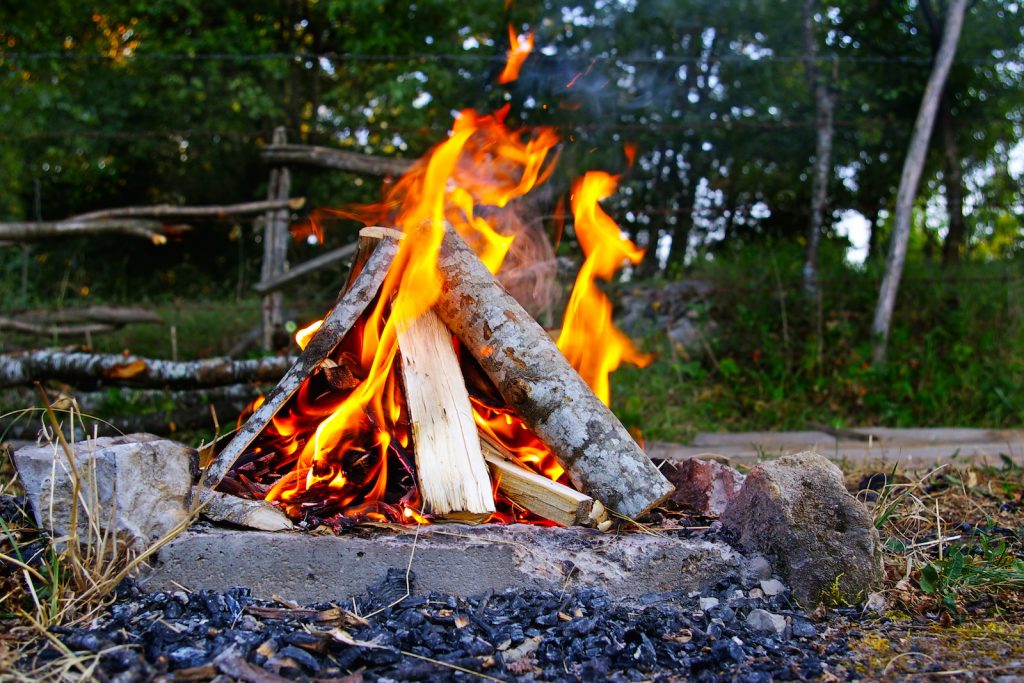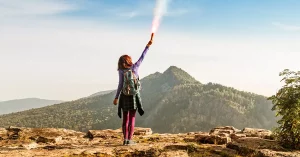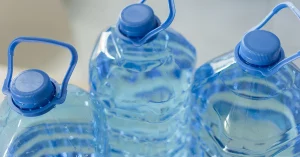Building a fire while you are in the outdoors is an essential survival skill. Fires are necessary for warmth, cooking, boiling water, and even signaling. We’ve compiled a few tricks for the best way to start a campfire as easily as possible. Some of these require tools and others can be completed using materials you’ll find in nature. There are also varying levels of difficulty.
Building a Fire Ring
You might be able to find a designated “fire ring” if you’re in a specified campground. These are designed to keep the fire contained and make sure it stays in control as well as that it is in a specific approved area.
If you are able to locate a fire ring, make sure that you check the area for any dry branches or leaves that could easily catch fire and spread the fire more than you’d like. Before you make the fire, make sure the pit is clean and free from any debris.
Best Wood to Get Your Fire Started
You’ll need three types of wood to build a fire: tinder, kindling, and firewood.
Tinder
The small stuff, the twigs and leaves, and needles.
Kindling
the smaller sticks that can catch on fire more easily than larger logs.
Firewood
The larger pieces or logs of wood that will provide the majority of the fuel for the fire.
Where to Find Wood for Your Campfire
If you’re at a registered campground, they may offer that you can purchase local firewood. Otherwise, you’ll need to scavenge for your own.
Purchasing Wood
You can purchase firewood from most campgrounds. If you want to have some sooner, then go to your local home improvement store. They will have bundles of wood already split and ready to be used.
Scavenging for Wood
Walk around your surrounding area where you’ve pitched your tent. Start grabbing any size sticks or logs that you come across that would be perfect for starting your survival campfire. Try to stay away from damp or wet logs if possible. These will be harder to light in the beginning but can be used later when the fire is burning.
Now that we’ve got our wood, let’s get into the best types of campfires to build!
Cone Fire
To create the cone shape, you create a cone if kindling and then fill tinder in the circle of the ring. You will add the logs once the fire is roaring.
Log Cabin Fire
For the log cabin, You put two pieces of wood parallel to each other and then place another two 90 degrees from there. You can keep adding layers, decreasing the size of the wood in each.
Pyramid Fire
For the pyramid, you put your largest logs side by side on the bottom and alternate size with each layer up. The kindling and tinder goes at the top of the pyramid. When it’s time to light the fire, you light the tinder and blow lightly at the base of the fire to add in oxygen which will make the fire spread more quickly and strongly.
Lean To Fires
Lean to fires are great if you are just learning how to start fires. They are easy to set up, but are not great for cooking and aren’t the warmest. All you do is put a long piece of kindling on the ground pointing to the wind, and begin to place pieces on top of each other to create a lean effect over the tinder. This won’t create the biggest fire, but it is the best way to start a campfire that won’t be taken out by the wind.
Log Cabins
A log cabin fire is great for cooking. You surround the tinder with kindling and stack as if you are legitimately building up the walls of a cabin; the pieces are put in right angles to create a square shape. This allows you to use the top portion as a resting area for a pan to cook food.
Upside Down Fire
In this fire, the tinder and kindling go on the top of the fire instead of the bottom. These fires burn for a long time because the heavier logs are on the bottom so they won’t crush the tinder and kindling. It takes a little more setup time than other types of fire methods, but it should keep burning for a longer period of time without maintenance.
Wooden Rocket Stove
These are made from drilling two holes in a log. One hole is drilled vertically and the other is drilled horizontally so that they meet in the middle. This is the best campfire for cooking food. You can also drill additional holes on the log and use string to make a handle if you need to grab your bug out bag and quickly move locations.
Match Free Fires
If you do not have fire-starting materials like lighter or waterproof matches readily available, you can turn to nature to get your fire started. You can use flint and steel to start a spark and have the sparks land on a small cloth that you can use to introduce a fire. You can also use a pair of glasses if you have sunlight. You put the tinder on the ground with the kindling and aim the beam of the sun at your pile until you see smoke starting to form. The easiest option would be to use friction. Using a knife you can shape a log to create a sharp spindle that you can rub to ignite sparks.
Preparing a Fire Starting Kit
While these are the best ways to start a campfire, you’ll always want to be prepared with a fire starting kit, or you might not be having a fire.
Fire Starting Storage Container
You will want to start with a watertight storage container that is portable and can fit in your bug out bag.
Waterproof Matches
The next essential is a lighter as well as waterproof matches. A regular lighter is a solid option to have, but it can be ineffective if there are wet conditions or a lot of rain. They can also break. So, you’ll want to have backup methods. Waterproof matches can be life-saving when your lighter fails, as they are able to hold a flame in windy conditions as well as heavy rain.
Ferro Rod
The next essential item to keep in your kit is a Ferro Rod. These rods are made with magnesium and iron and create a spark when you scrape it with a knife or a sharp material. They should still be able to spark in windy and wet conditions as well.
Fire Sticks
Fires sticks are another easy alternative, as they work like the Ferro Rods to scrape together and create sparks. To use these tools, you’ll also need a knife or other sharp object in your kit. This will also be helpful for shaving your tinder and wood.
On your next camping excursion or just in your backyard try all of these different ways to start a fire and see which one will work best for you. Having the knowledge of multiple fires design options will go a long way in making sure your prepared to light a fire any way in any situation.




